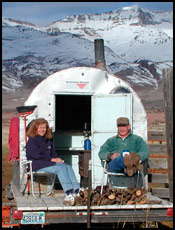
Ron Torell with his wife, Jackie.
Cow Camp Chatter
Artificial Insemination: Is it for your ranch?
Technology should not be oversold. A successful artificial insemination (AI) program takes time, labor, the facilities to properly process cattle multiple times, livestock handling skills and cows in adequate body condition and postpartum interval. It is imperative to have an understanding of the estrous cycle and heat synchronization protocol.
Time and effort is required for accurate heat detection. Unless you want 30% of your cows to be open, you will still need a cleanup bull or a second round of heat detection and AI. Following the process through diligently from the beginning, when the decision to AI is first made, to the end, when the last cow is bred, will yield the greatest success.
When considering AI, it is important to have at least a basic knowledge of the reproductive cycle of a beef cow. The lactating mature cows in an AI program should have a minimum body condition score (BCS) of 5 with a postpartum interval of 50 days or more. Cattle need to be on good feed and on the gain with long-term access to a quality mineral package.
Lactating young, thin, second-conception and short-postpartum interval cows are all poor candidates for an AI program. AI will not improve an already poor natural-breeding program. As a rule, any less than 3% of cows cycling daily at the onset of breeding indicates a low cyclicity rate of the herd.
Approximately 80% of the nation's commercial cow herds calve in February, March, April and May with corresponding breeding dates of May, June, July and August. During this same time period, cattlemen are busy with branding, fertilizing meadows, repairing fence and farm work. Fitting an AI program into this time frame is challenging.
During this labor-intensive breeding period, cattle are generally on pasture and away from facilities required for heat detection and AI. It is not surprising that less than 6% of the nation's mature cows are bred by AI.
Few commercial cattlemen utilize heat synchronization and AI on their yearling replacement heifers with only 16% of the nation's heifers bred artificially. High-accuracy AI calving-ease sires can be selected for heifers vs. a wider selection of high-accuracy growth bulls for mature cows. In comparison to lactating cows, yearling heifers do not have a calf at their side, which simplifies synchronization and the AI process. Yearling heifers often graze in pastures in close proximity to facilities capable of incorporating a synchronized, timed or heat detection AI breeding program.
New technologies and estrous synchronization protocols reported by the Beef Reproduction Task Force (http://beefrepro.unl.edu/resources.html) have revolutionized AI. Many of these new technologies have made it possible for AI to be more widely used by commercial cattlemen nationwide. AI conception rates and the costs associated with it are now within reach.
Synchronization resets the estrous clock on all females. Cattle not settling the first cycle have the opportunity to breed by natural service in 18 to 21 days. The end result is a large percentage of cattle calving in the first 35 days of the calving season. In a 35-day breeding period, all cattle have had the opportunity to breed twice. Because of the resulting longer postpartum interval (and less dystocia with heifers), there is better breed-back the following year with the next conception.
First-service conception rates on the average range from 40%-60% with synchronization and scheduled/timed AI. A 60%-80% first-service conception rate is attainable with synchronization, heat detection and AI. Success is dependent upon how well you've followed through with the entire process. There are no shortcuts to success.
The potential to improve the genetic foundation of a brood-cow herd utilizing a high-accuracy AI sire compared to a low-accuracy $4,000 bull is without equal. The risks that are associated with owning a bull — such as infertility, injury, maintenance costs, infection from a reproductive disease or death — are nonexistent with AI. Nevertheless, AI is not an inexpensive undertaking. Single-service semen costs for an AI sire range from $15-$30 per unit, with an additional expense of $10-$25 per head for synchronization, heat detection aids and labor. With the economy of size, these costs can be substantially reduced.
That's enough for this month. A special thanks to my wife, Jackie, for her part in writing "Cow Camp Chatter." As always, if you would like to discuss this article or simply want to talk cows, do not hesitate to contact me at 775-385-7665 or e-mail me.











